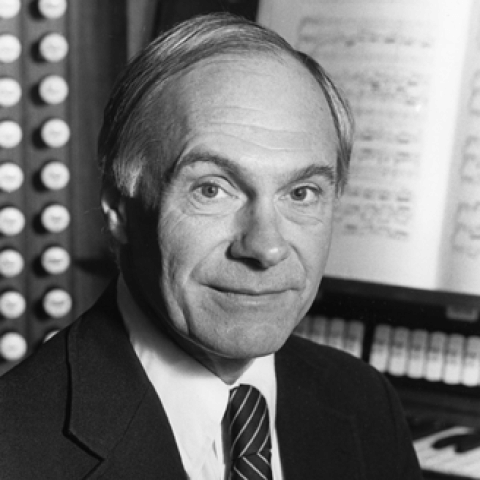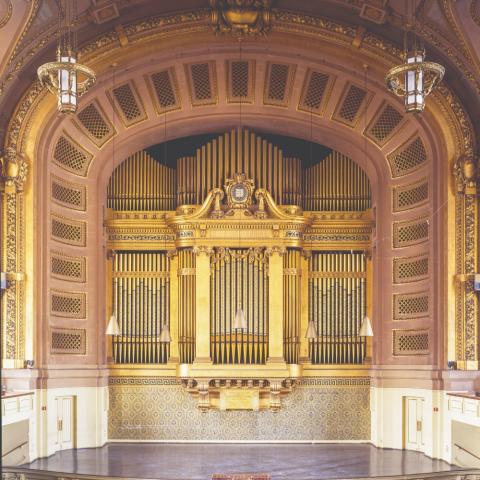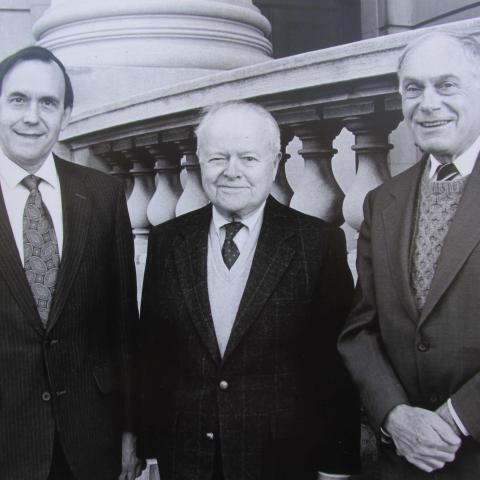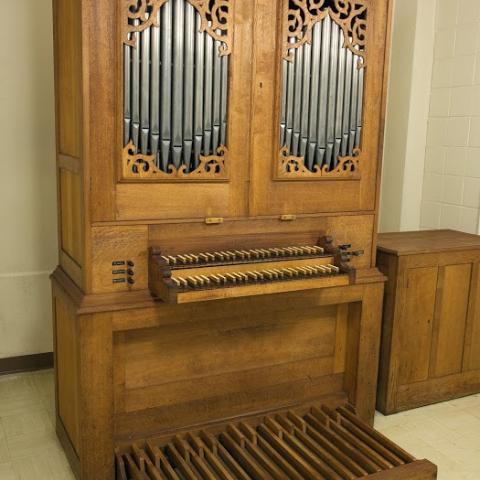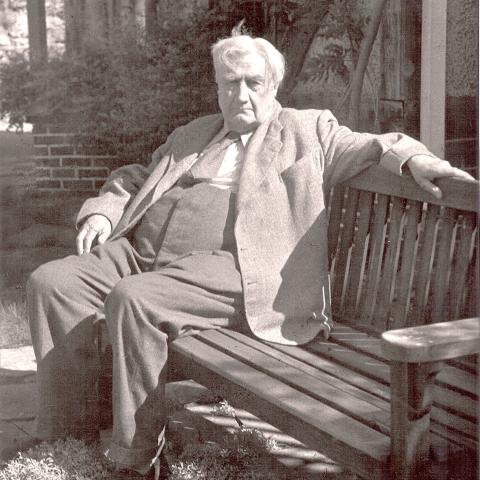Thomas Murray, now Professor Emeritus of organ at Yale, taught alongside Charles Krigbaum from 1981 to 1995 and succeeded him as the designated Yale University Organist.

On April 30, 2020, Yale Professor Emeritus Charles Russell Krigbaum died at the age of 91 in Beverly, Massachusetts. To generations of Yale University students he was a much-beloved teacher. His thirty-six years of service on the School of Music faculty spanned the regimes of four deans and five Yale University presidents. His performances, lectures, and masterclasses took him throughout the United States, to Europe, Japan, and the Far East.
Charles Krigbaum was born on March 31, 1929, in Seattle, Washington, and spent his youthful years in New Jersey, where he studied piano with Margaret Maass and organ with Margaret McPherson Dubocq. He earned his Bachelor of Arts (1950) and his Master of Fine Arts (1952) degrees from Princeton University, where he was a pupil of Carl Weinrich. Following his completion of Naval Officer Candidate School and three and a half years active duty he received a Fulbright grant to study at the Hochschule für Musik and the Goethe University in Frankfurt during 1956–1958; Helmut Walcha and André Marchal were his European teachers for organ.
He joined the Yale faculty in 1958 when there was a need for a junior instructor in organ and a desire to have professional leadership for music in Marquand Chapel at the Divinity School. The choir flowered under his well-organized management; with membership established at twenty-four voices, there was soon a waiting list. Concerts in churches where alumni were ministers gave added interest to the work of the singers, and within a few years his success led to an appointment as conductor of the University Choir in Battell Chapel, a position he held from 1961 to 1973, when the Institute of Sacred Music came to Yale, bringing Robert Fountain as the head of an entirely new choral program.
Charles’s time with the University Choir extended into the period when Yale became coeducational, necessitating the building of a new choral library, an important responsibility that he undertook with keen personal interest. William Sloane Coffin, then university chaplain, was a great lover of fine music and supported the University Choir in performing the Saint John Passion of J. S. Bach one year on Good Friday. Works commissioned during Charles’s regime included a choral Mass by Richard Donovan for unison men’s voices, with optional trumpet and tympani. “A very fine piece,” Charles recalled. Donovan’s Magnificat (TTBB voices) and his organ piece Antiphon and Chorale were later recorded in Battell Chapel for CRI.
Professor Krigbaum was instrumental in the design of the H. Frank Bozyan Memorial Organ, a significant legacy from his tenure at Yale. Bozyan (”Uncle Frank”) was university organist and a long-time member of the organ faculty who retired in June of 1965. Within a few years gifts from Bozyan’s family, colleagues, and admirers made it possible to commission the Rudolf von Beckerath organ in Dwight Memorial Chapel, a distinctive addition to Yale’s collection that has had a notable influence on Yale students for nearly a half century. Charles recalled the arrival of the organ: “Beckerath had suffered through a very difficult time installing an organ in New York City only a few months earlier. I was determined to make everything as happy for him and his crew as possible, and I believe it shows in the result. We gave them feasts of corn-on-the-cob, blackberry cobbler, plenty of beer, and some trips to the seashore near Newport. John Mander, who now presides over the London firm established by his father Noel, was an apprentice with Beckerath at the time and part of the installation team.” (Mr. Mander is now retired.)
Charles played the dedication recital and five all-Bach programs. During its first year the organ was played by a number of well-known visitors, but later the funding for guest performers dried up. Charles, ever eager to bring stimulating artists to Yale, was known to offer his services gratis to organists at other universities in exchange for their appearance in New Haven. This circumstance accounts for a memorable comment from Aubrey Thompson-Allen, curator of organs during those years, who was overheard one day making the wry observation: “Krig pro quo!”
Many events are recalled with pleasure—symposia on the Romantic organ, on Buxtehude, Widor, and Guilmant, not to mention the 1985 premiere (shared with John Ferris of Harvard) of Bach’s youthful chorale preludes in the Neumeister Collection. Among lighter moments was the visit of the Dalai Lama, when Charles had to locate a copy of the Tibetan national anthem. He obtained one from John Fenstermaker at Grace Cathedral in San Francisco (where the Dalai Lama had appeared some time previously). In Charles’s words: “the written music is indeed something to see—a melody for the right hand and a drone note for the left. I played the right hand on the Schalmei with a few other odds and ends. It seemed the sound of an exotic wooden instrument might work best. But, of course, there are only the two notes at a time, and the lower one never moves!” At the end, the Dalai Lama returned his appreciation with a reverential bow directed to Krigbaum in the gallery. Charles hastily faced him and returned the courtesy. It was the cause of some good-natured chuckles.
In teaching, Charles always sought to foster well-roundedness. “Universality” was his word for it. “A student who knows the Romantics should also be well acquainted with Scheidt and Couperin. If the earlier repertoire is what they bring from their past experience, they should come to love Widor and Messiaen just as much.” It is well known that Widor and Messiaen were two of Charles’s keenest interests. He became a staunch advocate for the renowned Newberry Memorial Organ in Yale’s Woolsey Hall as a persuasive vehicle for their music, recording much of Messaien’s organ music on LPs and later recording the complete organ works of Charles-Marie Widor for AFKA. An unedited recording of his live performance at the Organ Historical Society’s 1975 convention was issued on a two-disc set, An Evening at Woolsey Hall.
Charles Krigbaum retired from Yale in 1995. In 2007 a new three-manual Taylor & Boody instrument in the gallery of Marquand Chapel, commissioned by the Yale Institute of Sacred Music, was inaugurated and named the Krigbaum Organ in his honor.
In contemplating deep musical questions, he mused: “You know, the art of organ playing requires total commitment. Artistic growth is difficult to achieve without that.” Along with many, he had great concern about the direction of church music. “We are seeing so much democratization. Democratization in itself—certainly the ideal of simplicity—is not bad. But for better or worse America sets the fashion in popular culture—in music, clothing, movies. And when we see a popular, market-driven style of music taking over in the church, especially where there is carelessness and a casual approach, it makes me wonder: how deep is the faith? How much of this is the work of a true artist with deep belief?”
Charles Krigbaum is survived by his children Ruth (Herb) Rich and Mary Krigbaum of Beverly, and John Krigbaum (Denise), of Gainesville, Florida. He is also survived by four grandchildren Sam Rich, of Brooklyn, New York, Ben Rich, of Boston, Massachusetts, Jennie Krigbaum of Beverly, and Clara Krigbaum, of Gainesville.
Photo: Charles Krigbaum at the Newberry Memorial Organ, Woolsey Hall, Yale University, New Haven, Connecticut (photo courtesy: Yale Institute of Sacred Music)

